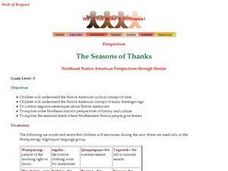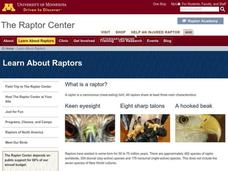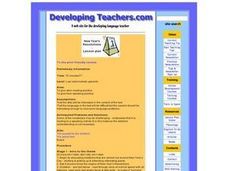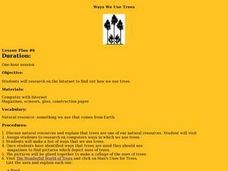Curated OER
Natural History of Costa Rica
Students use outline maps to become acquainted with Costa Rica. They see how it was formed and how its origin has created very diverse environments. Students then use atlases and compare their physical maps with maps of climate and the...
Curated OER
Nitrogen Fixation, OR What a Gas!
Students illustrate the adaptation and co-evolution of organisms. They examine set up an experiment to determine the effect of adding the Rhizobium bacteria to a group of legume seeds.
Curated OER
ESL Holiday Lessons: Biodiversity Day
In this language skills worksheet, students read an article about World Biodiversity Day. Students respond to 6 matching questions, 29 fill in the blank questions, 30 multiple choice questions, 12 word scramble questions, 30 short...
Curated OER
The Seasons of Thanks
First graders explain the Native American cyclical concept of time
Curated OER
The Rain Forest
Students explain the basics of the tropical rain forest ecosystem. They list the four general layers of vegetation found in the tropical rain forest.
Curated OER
Playing With Food - Food Sculpture
Students create decorative sculptures of various objects out of actual items of food.
Curated OER
New Year's Resolutions -Lesson plan
Learners study the origins of New Year's Resolutions while practicing taking dictation and identifying interesting points in a piece that is read to them. They investigate the types of things that people resolve on the first day of the...
Curated OER
Identifying Dinosaurs
Students investigate basic information about dinosaurs. They listen to the book, "My Visit To the Dinosaurs," explore various websites, take an online quiz, and play an online dinosaur game.
Curated OER
The Rainforest Community
Young scholars create a miniature rainforest ecosystem, a terrarium. Students then explain how the continuous flow of energy and food in the ecosystem allows it to sustain itself.
Curated OER
Lake and Pond Study
Students examine the habitat and community structure of a pond that could support Ospreys through games and worksheets. They then go on a field trip to a pond to evaluate the suitability of the pond as an Osprey habitat.
Curated OER
The Rain Forest
Students acquire knowledge about the basics of the tropical rain forest ecosystem. They analyze the cause/effect relationship between humans attitudes and behavior and the evnvironment. Students list the four general layers of vegetation...
Curated OER
Show Me Economics - Families Have Needs
First graders explore the four basic needs. Through discussion, 1st graders discover that all people need food, clothing, shelter and love. They create a collage representing the four basic needs. Students sing songs about basic needs.
Curated OER
Ride the Wild Leaf Cycle
Fourth graders complete a worksheet. In this life cycle lesson, 4th graders learn about the leaf cycle and complete a worksheet where they put the leaf cycle steps in the correct order.
Curated OER
Ways We Use Trees
Students use the Internet to find the ways we use trees. In this tree instructional activity, students make a list of the uses of trees and find magazine pictures that show these uses to make a collage. They read The Giving Tree by Shel...
Curated OER
What does the U.S. rice farmer use to grow rice?
Students discuss how a farmer grows rice. In this rice lesson, students discover the different tools needed to grow rice and how rice is cut and cleaned. They draw a picture of a rice farm.
Curated OER
Applied Science - Built Environment Post Lab (Energy)
Young scholars study science. In this efficiency lesson, students explore different forms of energy and compare them to determine which works the best. They work independently to create a collage of different energy sources (using...
Curated OER
Habitat Hopscotch
Students analyze different habitats. In this habitat instructional activity, students evaluate what animals need in their habitats. Students participate in the game Habitat Hopscotch.
Curated OER
Terrestrial Communities
Students watch a video about different terrestrial communities. They conduct an experiment with sponges conserving water. They research desert characteristics comparing them with other biomes.
Curated OER
What In The World Is A Harrow?
Students explain the values farming and industry have on the economy of Kansas. They research farm equipment uncluding price, types and purpose. They write a report about farm equipment.
Curated OER
Decomposing Artifacts
Seventh graders participate in an experiment in which they calculate the time of decomposition of different materials. In groups, they fill bags with different materials and cover them in soil. After six months, they create a line graph...
Curated OER
Earth's Recyclers
Students work together in groups to report on different topics related to decomposition. They answer questions and share their answers with the class. They discuss any topic that is unclear.
Curated OER
The Chain Gang
Students perform a food chain simulation to determine what happens when a food chain is broken.
Curated OER
Kansas vs the U.S.
Students demonstrate an understanding of the physical and political geography of Kansas. They view maps and films to gain knowledge of Kansas. They calculate the percentage Kansas harvests for each crop out of the national total.

























